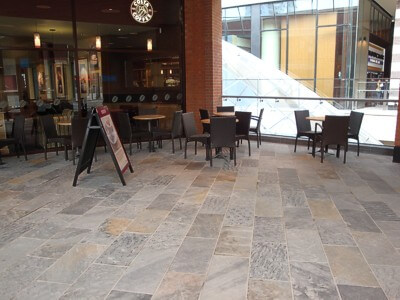Ten Potential Stone Problems & Solutions

Marble, granite, limestone and other decorative stone are durable materials that will last a lifetime. However, if not installed correctly or properly cared for problems may result that will shorten its life.
THE FOLLOWING ARE THE MOST COMMON PROBLEMS THAT MAY OCCUR
1. Loss of shine
The loss of the high polish on certain marble and granite can be attributed to wear. This is especially true of marble, since it is much softer then granite. When shoes track in dirt and sand, the bottoms of the shoes can act like sandpaper on a stone floor surface and over time will wear the polish off. A stone restoration professional can restore the polish.
2. Etching
The dull, whitish spot created when liquids containing acids are spilled on marble is called etching. Marble and limestone etch very easily. Granite is very acid-resistant and will rarely etch. To prevent etching, avoid using cleaners and chemicals that contain acids. Light etching can be removed with a little marble polishing powder. Deep etching or large areas will require the services of a restoration professional.
3. Stains
Some stone surfaces can become stained easily if they are not properly sealed. Many foods, drinks, ink, oil and rust can cause stains. Most stains on stone can be removed. For some, more difficult stains, professional techniques by a stone restoration provider may be the only hope. Permanent stains can occur but not often.
4. Efflorescence
Efflorescence appears as a white powdery residue on the surface of the stone. It is a common condition on new stone installations or when the stone is exposed to a large quantity of water, such as flooding. This powder is a mineral salt from the setting bed. To remove efflorescence do not use water. Buff the stone with a clean polishing pad or #0000 steel wool pad. The stone will continue to effloresce until it is completely dry. This drying process can take several days to as long as one year. Do not seal the stone until any efflorescense is gone.
5. Spalling, Flaking and Pitting
If your stone is developing small pits or small pieces of stone are popping off the surface (spalling) then you have a problem. This condition is common on stone exposed to large amounts of water or when deicing salts are used for ice removal. Like efflorescence, mineral salts are the cause for spalling and pitting. Instead of the salts depositing on the surface (efflorescence) they deposit below the surface of the stone, causing pressure within the stone, causing stone spalls, flakes or pits. Unfortunately once a stone begins to spall it is almost impossible to repair. It is recommended that the stone be replaced.
6. Yellowing
There are several reasons why a stone will turn yellow: Embedded dirt and grime can give the stone a yellow, dingy look. Waxes and other coatings can yellow with age. Certain stones will naturally yellow with age as a result of oxidation of the iron within the stone. This is especially problematic with white marbles. If the yellowing is caused by dirt or wax build up, have the stone cleaned with an alkaline cleaner or wax stripper. This may be a job best left to professionals. If the yellowing is the result of aged stone or iron oxidation, it is not coming out.
7. Uneven Tile (Lippage)
Lippage is the term given to tiles that are set unevenly. In other words, the edge of one tile is higher than the next and is the result of a poor installation. If the lippage is higher than the thickness of a nickel, it is considered excessive and the tile will have to be ground by a restoration contractor to flatten the floor.
8. Cracks and Chips
Cracks in stone can be caused by settling, poor installation, inadequate underlying support or excessive vibration. Chips can result from a bad installation or when a heavy object falls on a vulnerable corner.Repairs can be done by a professional stone restoration contractor by filling with a color matched polyester or epoxy.
9. White Stun Marks
Stun marks appear as white marks on the surface of the stone and are common in certain types of marble. These stuns are the result of tiny explosions inside the crystal of the stone. Pin point pressures placed on the marble cause these marks. Women’s high heels or blunt pointed instruments are common reasons for stun marks. Stun marks can be difficult to remove. Grinding and/or honing can reduce the number of stuns, but some travel through the entire thickness of the stone.
10. Water Rings/Spots
Water rings and spots are very common on marble and other natural stone surfaces. They are either areas that have become etched or are from hard water minerals such as calcium and magnesium that are left behind when water evaporates, leaving a ring or a spot. To remove either type of these spots, use a marble polishing powder. Moderate to severe etching or larger damaged areas will require professional honing by a stone restoration contractor.
If you require maintenance,repairs or new work and, are in South Wales(Neath, Swansea, Bridgend, Cardiff ) and please feel free to contact us to discuss your requirements.
